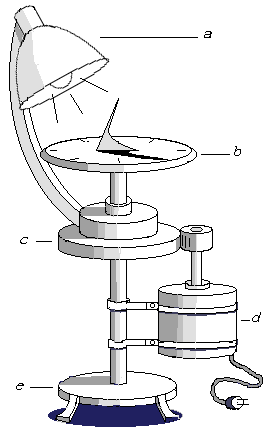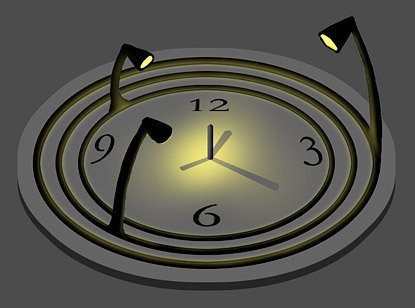Marc Abrahams's Blog, page 540
October 25, 2012
Egan’s indoor sundial, and its quasicompetitors
Tom Egan of Costa Mesa California invented an indoor sundial, which works by redirecting the sunlight. The photo, diagram, and result-trace below show how it works. Egan published a detailed description in The Compendium [the journal of the North American Sundial Society], vol. 19, no, 3, September 2012. The synopsis version of that says the device is:
a novel indoor sundial using an externally mounted convex mirror to compress the entire visual arc of the sky down to the size of the mirror. A pinhole in a mask on the window acts as a camera obscura, projecting the image of the sun onto an indoor dial face that can be as small as a letter-size piece of paper. The system has four parts: A convex mirror mounted just above the roof line; a pinhole lens affixed to the window; and two paired flat mirrors to relay the sun beam from the convex mirror through the pinhole and onto the dial face inside the building.
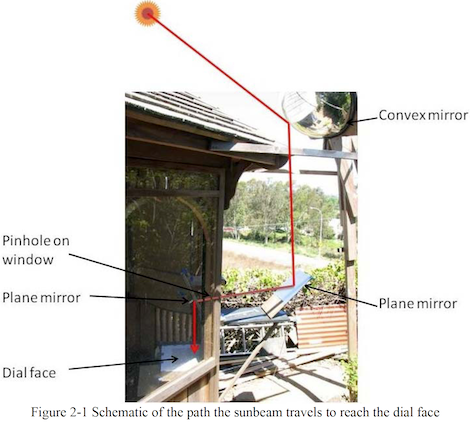
 BONUS: Others have invented, as jokes, reverse indoor sundials, which work by providing their own light source which rotates around a fixed dial. One is the Saddletrout Studio indoor sundial, pictured here:
BONUS: Others have invented, as jokes, reverse indoor sundials, which work by providing their own light source which rotates around a fixed dial. One is the Saddletrout Studio indoor sundial, pictured here:
Another is the Noddystuff Secondlife indoor sundial, pictured here:
Another, not at all for purists, is the three-light-source Bulbdial clock, pictured here:
BONUS: Tom Egan says that Isaac Newton, too, experimented with an indoor sundial:
“The earliest mention of Newton’s dial that I know of is on page 490, fifth paragraph of M. A. Gatty’s The Book of Sun-dials, 1900″:
“A further variety of sun-dials are those called reflective. In the numbers of “Aunt Judy’s Magazine” for March and April, 1878, there is a charming account of how Sir Isaac Newton placed a mirror on the floor of his room which reflected the sun’s rays on to the ceiling, upon which the hour lines were traced.”
Wikipedia has this, based on Waugh (Waugh AE (1973). Sundials: Their Theory and Construction. New York: Dover Publications. ISBN 0-486-22947-5.):
Reflection sundials
Isaac Newton developed a convenient and inexpensive sundial, in which a small mirror is placed on the sill of a south-facing window.[47] The mirror acts like a nodus, casting a single spot of light on the ceiling. Depending on the geographical latitude and time of year, the light-spot follows a conic section, such as the hyperbolae of the pelikonon. If the mirror is parallel to the Earth’s equator, and the ceiling is horizontal, then the resulting angles are those of a conventional horizontal sundial. Using the ceiling as a sundial surface exploits unused space, and the dial may be large enough to be very accurate.

October 24, 2012
The Further Adventures of The Meat Industry Research Institute of New Zealand
Lively, if not entirely cheerful, debate can be provoked by mentioning this study done by a researcher at the Meat Industry Research Institute of New Zealand:
“Effect of Stress-Related Changes in Sheepmeat Ultimate pH on Cooked Odor and Flavor,” T.J. Braggins, Journal of Agricultural and Food Chemistry, 1996, 44 (8), pp 2352–2360:
“In this study sheepmeat with a moderate or high ultimate pH (mean pH 6.26 and 6.81, respectively), which was induced by preslaughter adrenaline injection, had a significantly lower overall cooking odor and flavor intensity, as assessed by a trained sensory panel, than sheepmeat of a more acceptable pH (5.66).”

October 23, 2012
Dowsing : the low down
 Since 1962, the publication World Futures: The Journal of General Evolution has been
Since 1962, the publication World Futures: The Journal of General Evolution has been
“ … dedicated to the study of irreversible, nonlinear, system-structuring – that is evolutionary – change in nature and society.”
And, the publishers explain :
“All articles published in the journal have undergone rigorous editorial screening and peer review.”
For an example article see: Is Dowsing a Useful Tool for Serious Scientific Research? By Jeffrey S. Keen, BSc Hons ARCS MInstP CPhys Ceng.
“The act of observation can appear to affect the results of certain scientific experiments. Research has shown that the mind is much more than the brain. The perception of an observer may be significantly affected by the local and non-local environment, and is dependant on the time of the day, month, or year on which those measurements are made. This research has led toward a greater understanding of the structure of the universe, including its connection to consciousness and information. For example, it is demonstrated that the mind’s ability to communicate information from across the solar system is much faster than the speed of light.”
Although the paper’s abstract doesn’t completely answer the question which is posed in the title, the full paper (which Improbable has unearthed here) concludes that dowsing may indeed be a useful tool for serious scientific research – because :
1. The structure of the universe, from the Planck level to galaxies, enables 2 or more geometrical bodies to be “aware” of each others existence and precise location.
2. Similarly, the structure of the universe enables 3 geometrical bodies to “know” instantly when they are in perfect alignment.
3. As the same results are obtained for dowsing 3 large interacting cosmic bodies as for 3 micro objects, the findings support Global Scaling Theory.
4. The same phenomenon demonstrated as a result of geometric alignment for macro objects could equally apply to help explain quantum entanglement at the micro level.
5. There may be a strong connection between the subtle energies reported here, and “dark energy” which makes up over 75% of the universe.
Note: The picture shows divining-rod proponent Prof. Otto Edler von Graeve (1872-1948) , possibly on his way to locate Radium

Dack Stuart joins Hair Club (LFHCfS)
Dack Stuart has joined the Luxuriant Flowing Hair Club for Scientists (LFHCfS). He says:
My luxurious, flowing and award-winning hair (2011 Moustachio Bashio winner for “Most creative use of hair”, University of Delaware) often elicits “oohs”, “aahs”, and the occasional “whoa” upon entering a room. I originally grew it in college because that’s what college-age men do, but I decided to keep it once I noticed the hypnotic effect it has on people. People often ask for the pleasure of touching my luscious locks, and I need not expand on the effect it has on the fairer sex. My hair is particularly useful in making up for my inability to grow a luxurious flowing beard, and it really goes well with an outrageous Hawaiian shirt and a lei. In the world of marine consulting it looks especially dashing when I stand at the bow of ship, though it is often covered by a hard hat. My luxurious hair is not just for my own glamour: I have donated my hair twice to www.wigs4kids.org and I am currently growing it a third time for donation.
Dack Stuart, MA, LFHCfS
Coastal Scientist
Woods Hole Group
Woods Hole, Massachusetts, USA


Dropping and bouncing cats (a collection)
A small collection of items about dropped and bounced cats:
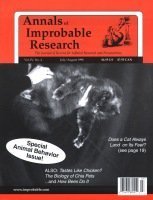 1. ”Does a Cat Always Land on Its Feet?” [article in Annals of Improbable Research, vol. 4, no. 4]
1. ”Does a Cat Always Land on Its Feet?” [article in Annals of Improbable Research, vol. 4, no. 4]
2. The Cat Bounce web site.
3. Dead Cat Bounce, the stock market metaphor.
4. The physics of skulking and falling cats.
(Thanks to investigator John Runions for suggesting the conjunction of #1 and #2.)

October 22, 2012
Testing pumpkin-carving knives on cadaver arms
The knifing of pumpkins, an innocent-seeming yet carefully planned act of mutilation, sometimes results (accidentally or otherwise) in sprays, bits and smatterings of human, as well as vegetable, gore. In such cases, blood –human blood – flows, drips and coagulates.
 A hands-on experiment, or rather, an experiment on hands, in 2004, tried to determine the level of medical danger an amateur can and should expect when using a pumpkin-carving tool.
A hands-on experiment, or rather, an experiment on hands, in 2004, tried to determine the level of medical danger an amateur can and should expect when using a pumpkin-carving tool.
Alexander M Marcus, Jason K Green and Frederick W Werner [pictured here] at the State University of New York Upstate Medical University in Syracuse published a study, called The Safety of Pumpkin-Carving Tools, in the journal Preventive Medicine.
“Pumpkin-carving accidents”, they inform their peers who read the report, “may leave people with compromised hand function”….
So begins this week’s Improbable Research column in The Guardian.
BONUS: Detail from the study:
BONUS: Martha Stewart carves a pumpkin:

Diane McCarthy Joins Hair Club (LFHCfS)
Diane McCarthy has joined the Luxuriant Flowing Hair Club for Scientists (LFHCfS). Mark McCracken, who nominated her, says:
Diane McCarthy, to whom I have the honor to be married, recently defended her thesis in Biology regarding the phylogeography of Tilia Americana, and then promptly moved to Colorado in search of new challenges. She has presented to wild acclaim at two different Botany Conferences (2009, 2011). She finds her luxuriant flowing hair to be quite useful for storage and indexing of T. Americana samples. She also has a background in Urban Planning, and is interested in integrating the two disciplines so as to help humankind more harmoniously co-exist with nature
Diane McCarthy, PhD, LFHCfS
Recent Graduate of the Department of Biological Sciences
Program in Ecology and Evolution
University of Illinois at Chicago, USA
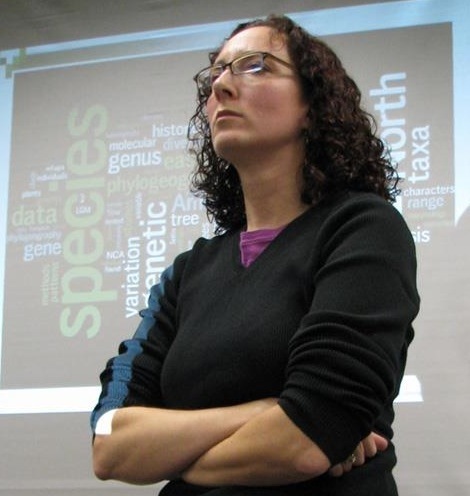

Kitiporn: A New Way to Use Durians
A scientist named Kitiporn has helped develop an innovative way to use durians, a fruit that some people find highly offensive. Details are in the study:
“Development of Durian Flour Production,” Ravin Suabkha; Komkit Kitiporn, et al., Proceedings of the 18th Rajamangala Institute of Technology conference: Abstracts, Rajamangala Institute of Technology, Bangkok (Thailand). Research and Development Inst..- Bangkok (Thailand), 2001, pp. 22-23. The authors, at Rajamangala Institute of Technology. Thailand, report:
“Green durian cutter, a green durian slicer and a green durian flour mill were developed. Meanwhily, the production of durian flour from green durian fruit was also studied…. The finding revealed that increasing the sieve diameter decreased the degree of fineness of the durian flour but increasing the capacity of the machine. The suitable speed of the milling with a 1-millimeter diameter sieve was 2930 rpm and the capacity was 26.85 kilograms per hour.”
(Thanks to investigator Mason Porter for indirectly bringing this to our attention.)
BONUS: Video addressing the question “How smelly is a durian?”

October 21, 2012
Nasal topsy-turvyism examined
 More than one scientific investigator has examined the implications of misplaced facial attributes in drawings. [Example] But fewer have drawn attention to the implications of a facial attribute which actually is misplaced (rather than just in an illustration). What would happen for example, if one’s nose was upside down? This question was asked – and hypothetical answers provided – in a letter to the Singapore Medical Journal 47(8), in which professor Biji T. Kurien PhD of the Oklahoma Medical Research Foundation performed a thought-experiment investigating Survivability with a topsy-turvy olfaction/respiration organ. The professor outlined a variety of possible drawbacks to an upside-down nose. What would happen in a rainstorm for instance? To say nothing of the problems of overflying birds. And smokers might find their vision severely impaired when exhaling.
More than one scientific investigator has examined the implications of misplaced facial attributes in drawings. [Example] But fewer have drawn attention to the implications of a facial attribute which actually is misplaced (rather than just in an illustration). What would happen for example, if one’s nose was upside down? This question was asked – and hypothetical answers provided – in a letter to the Singapore Medical Journal 47(8), in which professor Biji T. Kurien PhD of the Oklahoma Medical Research Foundation performed a thought-experiment investigating Survivability with a topsy-turvy olfaction/respiration organ. The professor outlined a variety of possible drawbacks to an upside-down nose. What would happen in a rainstorm for instance? To say nothing of the problems of overflying birds. And smokers might find their vision severely impaired when exhaling.
The full thesis may be examined here.

October 20, 2012
Beethoven for elephants
Marc Abrahams's Blog
- Marc Abrahams's profile
- 14 followers


